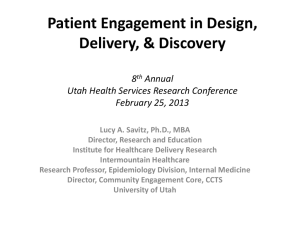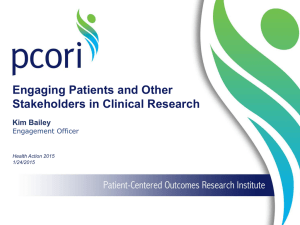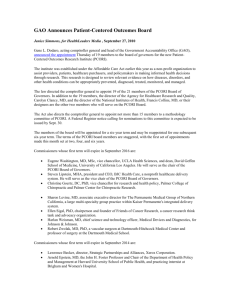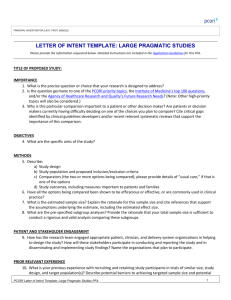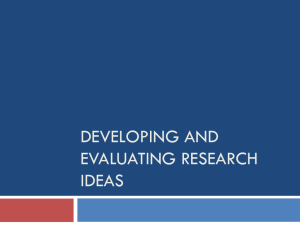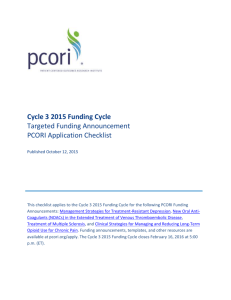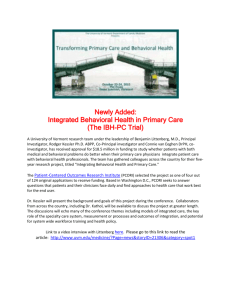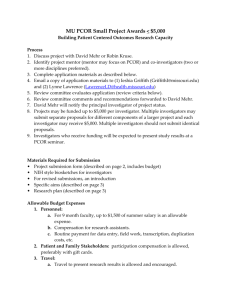Partnering with Patients and Families in Research
advertisement
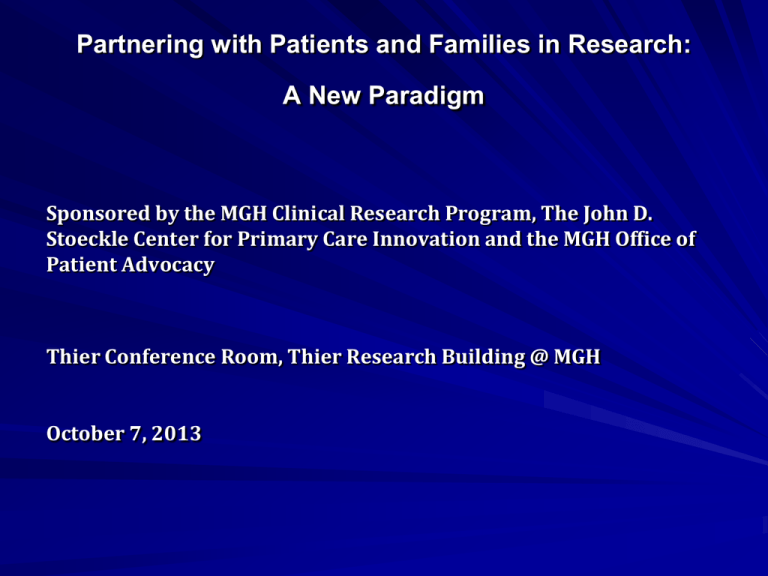
Partnering with Patients and Families in Research: A New Paradigm Sponsored by the MGH Clinical Research Program, The John D. Stoeckle Center for Primary Care Innovation and the MGH Office of Patient Advocacy Thier Conference Room, Thier Research Building @ MGH October 7, 2013 Goals of the Program Explore – Discuss patients and families as collaborators in research at MGH – Explore MGH current environment for engaging patients and families in research – Identify and prioritize potential next steps for MGH and the Clinical Research Program Patient And Family Partnerships in Research Susan Edgman-Levitan, PA Executive Director Stoeckle Center for Primary Care Innovation Massachusetts General Hospital October 7, 2013 The John D. Stoeckle Center for Primary Care Innovation What is Patient- and Family-Centered Care? “Health care that establishes a partnership among practitioners, patients, and their families…to ensure that decisions respect patients’ wants, needs, and preferences and that patients have the education and support they need to make decisions and participate in their own care.” Crossing the Quality Chasm: A New Health System for the 21st Century, Institute of Medicine, 2001 & The Picker Institute The John D. Stoeckle Center for Primary Care Innovation Figure 1. A Multidimensional Framework for Patient and Family Engagement in Health and Health Care Source: Carman et al., 2013; Scholle et al., 2010 The John D. Stoeckle Center for Primary Care Innovation Global Patient/Family Partnerships and Engagement • • • • • • • • • PCORI Private Foundations AHRQ/NIH Gordon and Betty Moore Foundation Patient Care Program: $500M for patient engagement research and implementation MA, 2008 “An Act to Promote Cost Containment, Transparency and Efficiency in the Delivery of Quality Health Care.” World Innovation Symposium in Healthcare 2013: Patient engagement recommendations for health, economic, and education ministers around the world Lucian Leape Institute: Safety is Personal Report NHS Patient Constitution WHO Patients for Patient Safety The John D. Stoeckle Center for Primary Care Innovation The Value of Patient and FamilyCentered Care • Patients are the only source of information about many aspects of quality. • The patient’s experience is linked to improved clinical outcomes, reduced readmissions, reduced mortality, and reduced malpractice risk, and improved ability to manage chronic conditions. • Partnering with patients and families brings a wealth of knowledge to clinicians and staff that they do not possess. • Partnerships with patients and families inspire and energize clinicians, staff, and leaders while grounding them in reality, focused on the “right” solutions. The John D. Stoeckle Center for Primary Care Innovation Patients &Families as Partners: the Benefits Patients/Family Clinicians/Staff Organization Opportunity to affect change Enhances relationships with patients/families Improves quality of services and programs Improves clinical outcomes Improves clinical outcomes Keeps programs relevant and realistic Builds knowledge/skill Develops knowledge and skills Brings creative solutions Models empowerment Provides a reality for others check and fresh perspective Helps save money: 1040% reduction in costs Network with others Improves philanthropy support and advocacy for org/service. Increases empathy and understanding The John D. Stoeckle Center for Primary Care Innovation Examples of Patient/Family Feedback at PHS and Partners • Identified positives and negatives about current practices and where to save money. – Electronic medical records – Creation of patient/clinician compacts – Insulin induction – Colonoscopy results – Design of Yawkey Building • Identified issues in patient education materials, letters, and marketing materials – Diabetes – End of life – Pediatrics – Transplant booklet – Care team descriptions The John D. Stoeckle Center for Primary Care Innovation Characteristics of Excellent Patient/Family Partners • The ability to share personal experiences in ways that others will listen and learn from them. • The ability to see the “big” picture. • Interested in more than one issue. • Interested in improving health care or research. • The ability to ask tough questions constructively. • The ability to connect with people. • A sense of humor. • Representative of the relevant patients/families/conditions. The John D. Stoeckle Center for Primary Care Innovation Barriers: Clinician/Investigator Concerns • Research issues are too technical for lay people to understand • Paternalism/loss of “expert” status • Patients/families are too overwhelmed to participate • Patients/families will see the “messy” side and problems of medicine • Patients/families will express feelings in a negative and critical manner • Unrealistic requests or expectations The John D. Stoeckle Center for Primary Care Innovation Barriers: Patient and Family Concerns • Don’t trust that clinicians/staff will listen • Clinicians will underestimate the value of their perspective • Logistics – No mechanism for providing child care – Transportation is difficult or unavailable – Meetings are only held during working hours – Patients/families lose time/money from their families/jobs – Translator services The John D. Stoeckle Center for Primary Care Innovation Barriers: System Issues • Staff/patients/families have never participated in research studies before – Lack of knowledge of each other’s roles – Use of jargon – Addressing confidentiality issues • Recruiting the right people • No mechanism to reimburse or compensate patients/families • Lack of resources for training staff and families to work in partnership • Staff cannot be paid overtime for meetings after hours. The John D. Stoeckle Center for Primary Care Innovation Barriers: Lack of Quantitative and Qualitative Research Support • Structured interviews: patients, families, employees who have been patients • Focus Groups • Observations • Ethnographies • Surveys The John D. Stoeckle Center for Primary Care Innovation Patient/Family Orientation Programs • • • • • The mission, goals, and priorities of the organization. Who’s who in the organization and/or on the project team and how to contact other team members. Basic volunteer program orientation and training. HIPAA and the importance of privacy and confidentiality. Specific skills and knowledge needed to be an effective team member ,e.g., quality improvement or research methodologies. • • • • “Jargon 101.” While it is best to reduce the amount of jargon used in meetings, sometimes it is impossible to completely eliminate jargon. If there are terms that will be used frequently, make sure that advisors understand them. How to prepare for a meeting: appropriate attire, what to do ahead of time, and what to bring. How meetings are conducted: format, agenda, minutes, roles (e.g., facilitator, secretary, timekeeper). Technologies that will be used (e.g., conference calls, web-based tools). The John D. Stoeckle Center for Primary Care Innovation Potential Models for Advanced Patient/Family Training The John D. Stoeckle Center for Primary Care Innovation National Breast Cancer Coalition Clinical Trials Project LEAD® • a four-day advanced course open to graduates of Project LEAD® Basic Science and the Project LEAD® Institute. The course focuses on understanding and improving breast cancer clinical trials research. This course, part of NBCC’s Clinical Trials Initiative, trains advocates to participate in all levels of the clinical trials process from evaluating trial design to serving on Institutional Review Boards and Data Safety Monitoring Boards. The John D. Stoeckle Center for Primary Care Innovation National Breast Cancer Coalition Project LEAD® Institute • Taught by a renowned research faculty, this is a five-day intensive science course for breast cancer advocates covering the basics of cancer biology, genetics, epidemiology, research design and advocacy. • Participants will: – Learn the language and concepts of the science of breast cancer, including cancer biology, genetics, genomics and proteomics, the roles of DNA, RNA, and proteins, and the development of cancer at the molecular level; – Distinguish between descriptive studies, analytic studies, clinical trials, and metaanalyses, and identify the extent to which each establishes causality; – Acquire the skills to critically interpret scientific literature, and to become educated about scientific aspects of breast cancer; – Become familiar with the wide range of consumer advocacy opportunities, and how breast cancer research decisions are made; – Gain the necessary leadership and advocacy development skills to confidently participate in the scientific community as a breast cancer advocate. – The John D. Stoeckle Center for Primary Care Innovation PCORI National Priorities for Research Projects that address critical decisions that patients, their caregivers, & clinicians face with too little information The John D. Stoeckle Center for Primary Care Innovation PCORI: 5 Merit Review Criteria 1.Impact of the condition on the health of individuals & population 2.Potential for improving care & outcomes 3.Technical merit 4.Patient-centeredness 5.Patient & stakeholder engagement in the formulation of research questions, design, implementation, monitoring, & reporting The John D. Stoeckle Center for Primary Care Innovation “Honest criticism is hard to take, particularly from relative, a friend, an acquaintance, or a stranger.” Franklin P. Jones The Saturday Evening Post The John D. Stoeckle Center for Primary Care Innovation Those who say it cannot be done should not interrupt the person doing it. -Chinese Proverb The John D. Stoeckle Center for Primary Care Innovation References & Resources • Barry MJ, Levitan SE. Shared Decision Making—the Pinnacle of Patient-Centered Care. N Engl J Med 2012; 366:780-781. • Gerteis M, Edgman-Levitan S, Daley J, Delbanco TL, editors. Through the Patient’s Eyes. San Francisco: Jossey-Bass Publishers, Inc.; 1993. • Edgman-Levitan S, Shaller D, McInnes K, Joyce R, Coltin K, Cleary P. The CAHPS Improvement Guide: Practical Strategies for Improving the Patient Care Experience. CMS, Baltimore, MD; 2003 • Delbanco T, Berwick D, Boufford JI, Edgman-Levitan S, Ollenschlager G, Plamping D,Rockefeller RG. Healthcare in a Land Called PeoplePower: Nothing About Me Without Me. Health Expectations, 2001 Sep; 4 (3): 144-50. The John D. Stoeckle Center for Primary Care Innovation References & Resources • William Boulding, PhD; Seth W. Glickman, MD, MBA; Matthew P. Manary, MSE; Kevin A. Schulman, MD; and Richard Staelin, PhD. Relationship Between Patient Satisfaction With Inpatient Care and Hospital Readmission Within 30 Days - Page 2 (Am J Manag Care. 2011;17(1):41-48) • Luxford K. What does the patient know about quality? International Journal for Quality in Health Care 2012; Volume 0, Number 0: pp. 1–2 • Greaves F, Pape UJ, King D, Darzi A, Majeed A, Wachter RM, Millett C. Associations between web-based patient ratings and objective measures of hospital quality. Arch Intern Med. 2012 Mar 12;172(5):435-6. Epub 2012 Feb 13. • Isaac T, Zaslavsky AM, Cleary PD, Landon BE. The relationship between patients' perception of care and measures of hospital quality and safety. Health Services Res 2010;45(4):1024-1040. The John D. Stoeckle Center for Primary Care Innovation References & Resources • Sorra J, Khanna K, Dyer N, Mardon R, Famolaro T. Exploring relationships between patient safety culture and patients' assessments of hospital care. J Patient Saf. 2012 Sep;8(3):131-9. • Lehrman WG, Elliott MN, Goldstein E, Beckett MK, Klein DJ, Giordano LA. (2010). Characteristics of Hospitals Demonstrating Superior Perfomance in Patient Experience and Clinical Process Measures of Care. Medical Care Research and Review, 67(1):38-55. • Fremont AM, Hargraves JL, Rowe RM, Jacobson NB, Ayanian JZ. Patient-Centered Processes of Care and Longterm Outcomes of Myocardial Infarction. JGIM, 2001:16:800-808. • Cleary PD. A Hospitalization from Hell: A Patient’s Perspective on Quality. Ann Intern Med. 2003 Jan 7;138(1):33-9. The John D. Stoeckle Center for Primary Care Innovation References & Resources • Webster, PD, Johnson, B. Developing and Sustaining a Patient and Family Advisory Council, Institute for FamilyCentered Care, 2000. • Johnson, B., Abraham, M., Conway, J., Simmons, L., Edgman-Levitan, S., Sodomka, P., Schlucter, J., & Ford, D. (2008). Partnering with patients and families to design a patient-and family-centered health care system: Recommendations and promising practices. Bethesda, MD: Institute for Family-Centered Care. Available from http://www.ipfcc.org/ resources/index.html • Patient-Centered Care: What Does It Take? Dale Shaller www.pickerinstitute.org/Research/shaller.pdf The John D. Stoeckle Center for Primary Care Innovation Resources • • • • • • • • • www.stoecklecenter.org www.pcori.org www.nbcc.org www.ifpcc.org www.npsf.org www.ahrq.gov www.hospitalcompare.hhs.gov www.ihi.org www.planetree.org The John D. Stoeckle Center for Primary Care Innovation Thank You! Susan Edgman-Levitan, PA Executive Director sedgmanlevitan@partners.org 617-643-3931 John D. Stoeckle Center for Primary Care Innovation Massachusetts General Hospital Boston, MA The John D. Stoeckle Center for Primary Care Innovation Partnering with Patients and Families in Research: A New Paradigm October 7th, 2013 Susan Sheridan, MBA MIM Laura Forsyth, PhD MPH 29 PCORI An independent non-profit funder of clinical comparative effectiveness research. Authorized by Congress as part of the 2010 Patient Protection and Affordable Care Act (ACA). 30 A New Paradigm 31 Why PCORI? Research has not answered many questions patients face People want to know which treatment is right for them Patients need information they can understand and use Research has not answered many questions patients face People want to know which treatment is right for them Patients need information they can understand and use 32 Our Mission PCORI helps people make informed health care decisions, and improves health care delivery and outcomes, by producing and promoting high integrity, evidence-based information that comes from research guided by patients, caregivers and the broader health care community. Pictured: PCORI Board of Governors (March 2012) 33 Our National Priorities for Research Assessment of Prevention, Diagnosis, and Treatment Options Improving Healthcare Systems Communication & Dissemination Research Accelerating PCOR and Methodological Research Addressing Disparities 34 Our Growing Research Portfolio Total number of research projects awarded to date: 197 Total funds committed to date: $273.5 million Number of states where we are funding research: 36 states (including the District of Columbia) Minimum research commitment in 2013: $400 million 35 “Research Done Differently” Patient engagement as a path to rigorous research Tell us what PCORI should study Help determine what we fund Engagement Tell us how we are doing Help us share research findings Partner in the conduct of research Tell us what PCORI Should Study Submit your questions: • online: www.pcori.org/questions • Workshops • Roundtables • Engagement Awards • Ambassador program I want to know which blood glucose testing approach is best for me to manage my diabetes. Tell us what PCORI should study Engagement I want to know which asthma management tool will help my child’s asthma Which Anti Epileptic Drug (AED) will have less long term impact on my child’s cognition Which support group intervention is best for Latina breast cancer survivors and their caregivers? Help determine what we fund Advisory Panels & Working Groups PCORI Reviewers Help determine what we fund Engagement 38 Participate as a “Patient Partner” in PCORI funded research Tell us what PCORI should study Help determine what we fund Engagement Tell us how we are doing Help us share research findings Partner in the conduct of research PCORI Merit Review Criteria Criterion 1. Impact of the condition on the health of individuals and populations Criterion 2. Potential for the study to improve health care and outcomes Criterion 3. Technical merit Criterion 4. Patient-centeredness Criterion 5. Patient and stakeholder engagement 40 Patient-centered requirements for funding (Review criteria) Patient and Stakeholder Engagement Patient-Centeredness 41 Methodology Standards Associated with Patient-Centeredness PC-1 Engage people representing the population of interest and other relevant stakeholders in ways that are appropriate and necessary in a given research context. Stakeholders can be engaged in the processes of: Formulating research questions; Defining essential characteristics of study participants, comparators, and outcomes; Identifying and selecting outcomes that the population of interest notices and cares about (e.g., survival, function, symptoms, health-related quality of life) and that inform decision making relevant to the research topic; Monitoring study conduct and progress; and Designing/suggesting plans for dissemination and implementation activities. 42 PCOR Engagement Principles Honesty Partnerships Reciprocal Relationships Trust Transparency Incorporates the Engagement Principles* and conceptual framework of patient engagement in research developed by PCORI’s scientific team (Source: Curtis, P, Slaughter-Mason, S, Thielke, A, Gordon, C, Pettinari, C, Ryan, K, Church, B, King, V(2012). PCORI Expert Interviews Project) Co-learning 43 Participate as a “Patient Partner” in PCORI funded research Help determine what needs to be researched Help recruit participants Help create the intervention to be studied Evaluate the engagement throughout the life of the project Define outcomes important to patients Disseminate research results to advocacy organizations and community Help write proposal Participate as Co-PI, consultant or advisory committee member Help determine methods and processes of research study 44 Conceptual Model for PCOR Outcomes Outcomes • Culture of patientcenteredness in research • Meaningful & effective partnerships Near-term • Research relevant to patients/other stakeholders • Use of research results in health decisions Actions • Initiate and maintain partnerships between researchers and stakeholders • Facilitate cross-communication among research stakeholders Foundational Elements • Awareness of methods for PCOR • Valuing of the patient perspective • Interest in PCOR • Ways for patients and researchers to partner • Resources and infrastructure • Policies/governance • Capture, use and optimize patient perspective across phases of research • Ensure meaningful influence on research • Train for partnering • Share and use learnings • Quality health decisions • Satisfaction with health care experiences • Optimal health outcomes Intermedia Long-term PCOR Principles Trust, Co-learning, Transparency, Respect Conceptual Model of PCOR: Foundational Elements Awareness of methods for PCOR Valuing of the patient perspective Interest in PCOR Ways for patients and researchers to partner Resources and infrastructure Policies/governance Conceptual Model of PCOR: Actions Initiate and maintain partnerships between researchers and stakeholders Facilitate cross-communication among research stakeholders Capture, use and optimize patient perspective across phases of research Ensure meaningful influence on research Train for partnering Sharing and use of learnings Conceptual Model of PCOR: Outcomes Near term outcomes Culture of patient-centeredness in research Meaningful & effective partnerships Intermediate outcomes Research relevant to patients/other stakeholders Use of research results in health decisions Quality health decisions Satisfaction with health care experiences Long term outcomes Optimal health outcomes Patient engagement in research Improved research recruitment and retention rates (Edwards et al. 2011) Enhanced trust between researchers and participants (Decker et al. 2010; Edwards et al. 2011; Staniszewska et al . 2007) Improved content and construct validity of measures (Cashman et al. 2008; Cotterell 2008) Improved patient understanding of results (Chalmers 1995; McCauley et al. 2001; Doyle 2010) Increased relevance of research results to patients (summarized in Nass et al. 2012) PCORI Pilot Projects Program 50 projects in 24 states and Washington, DC $31 million (over two years) 50 PCORI Pilot Projects: Stakeholder Engagement 0 Patient(s)/Consumer(s) Caregiver(s)/Family Member(s)/ of Patient Patient/Consumer/Caregiver Advocacy Organization(s) Clinician(s) Clinic/Hospital/Health System Representative(s) Purchaser(s) Payer(s) Industry Representative(s) Policy Maker(s) Other 10 Percent Reporting Engagement 20 30 40 50 60 70 80 90 100 Patient Engagement: Stages of the Research Process 0 Topic solicitation/agenda setting Question development/framing Proposal development Methods/study design Data collection Data analysis Results review/interpretation/translation Dissemination 10 20 30 40 % 50 60 70 80 90 100 Facilitators for Engagement Not at all Somewhat Critically Important Important Important Important Remuneration (e.g., honoraria, travel support) 16% 28% 40% 16% 24% 16% 44% 16% 13% 29% 42% 17% Communications strategies 7% 7% 33% 52% Shared leadership strategies 8% 21% 21% 50% Training/education of stakeholders Training/education of researchers Most Significant Contributions To-Date (~6 months into funding) Changes to project methods, outcomes, or goals Modifications to interventions Helps open doors to clinical settings/ access to clinical professionals Refinement of instruments and interview questions Contribute to interpretation of qualitative findings Ways to improve the ease of data collection for patients and providers, should speed data collection Inform dissemination strategies Pilot Projects: Lessons Learned Seek genuine partnership Strategic selection of stakeholders Continuous involvement of stakeholders Adapt to the practical needs of stakeholders Define expectations and roles Building relationships requires in-person contact A New Paradigm 56 Example - Nueva Vida Intervention: Improving QOL in Latina Breast Cancer Survivors and their Caregivers Intervention itself was developed by breast cancer survivors Patient/stakeholder partners include clinicians (also cancer survivors), patient survivors, caregivers and patient advocacy organizations from diverse locations of the United States including Washington DC area, New York and California. Patient advocacy organizations and patients/caregiver research partners are compensated sub contractors and consultants in project Patient advocacy research partners helped develop choice of comparator, eligibility criteria (all women with breast cancer would be eligible vs. only women who had completed active treatment) 57 Example - Nueva Vida Intervention: Improving QOL in Latina Breast Cancer Survivors and their Caregivers Interventionist training provided by patient advocacy organization, patient/survivor and clinician/caregiver Frequent opportunities for check-ins/meeting across all project partners (“early and often”) Research team including patient/stakeholder partners involved in discussion of study implementation, Institutional Review Board protocols, recruitment, participant tracking, intervention delivery, and outcomes assessment. Patient Partners to share results through outreach to 150+ local and national groups that provide care and support to tens of thousands of Latino families facing cancer as well as participation in Biennial National Latino Cancer Summit. 58 Example - Cognitive AED Outcomes in Pediatric Localization Related Epilepsy (COPE) The purpose of this project is to identify the AED that maximally preserves cognitive function in children with Epilepsy Patient Partners include a patient advocate, the National Epilepsy Foundation and treating Clinicians The patient advocate has epilepsy and a grassroots website (myepilepsystory.org) connecting others with Epilepsy who reviewed early drafts of the research design and endorsed the design. Patient advocate partner originated the idea of a survey tool for the children and helped craft survey language 59 Example - Cognitive AED Outcomes in Pediatric Localization Related Epilepsy (COPE) Patient advocate partner serves on the Research Executive Committee is compensated as a consultant and participates in the investigator meetings as well as all teleconferences during the study to contribute to the conduct and study progress Patient Partner will post study description on monthly updates on her website and include final study results. She will collaborate with the Epilepsy Foundation and media to share the importance of this study. The National Epilepsy Foundation will be the primary source of sharing the results of the study to the American Epilepsy Society and to patients and their families including a patient friendly video of the PI of study results. Clinicians and site PIs who are responsible for medical management of pediatric LRE will serve on the Executive Committee as well. 60 Example - Addressing Mental Health Needs of Rural African Americans Patient Partner is a Tri County Rural Health Network and their community members Patient Partner helped write the proposal with their community members involved in a deliberative democracy process that incorporates decision-making directly by lay citizens, (instead of focus groups) Patient Partner created a community advisory board that advised on patient friendly informed consent forms, procedures and recruitment Patient Partner re-framed the research question, application and interview guide on a “wellness perspective” instead of a mental health angle to be more culturally accepted 61 Example - Addressing Mental Health Needs of Rural African Americans Mental Health vs. Emotional Wellness No one is going to talk to you about mental health. When people hear mental health they think of crazy. Ain’t nobody going to talk to you about being crazy. I ain’t crazy, I don’t know how to help you help crazy people If you want my expertise, you have to ask me about t 62 Tips - Promising Practices of Meaningful Engagement in the Conduct of Research Patient Partners involved in: identifying a priority topic and developing the research question to be studied creating the intervention to be studied (if applicable ) identifying the comparators to be used in the study identifying the goals or outcomes of the interventions to be studied 63 Tips - Promising Practices of Meaningful Engagement in the Conduct of Research The Patient Partners co-develop methods and processes for the research project as appropriate. The Patient Partners co-deliver research methods/activities as appropriate. The research team, including Patient Partners, actively evaluates engagement throughout life of the project 64 Tips - Promising Practices of Meaningful Engagement in the Conduct of Research Patient Partners are involved in the dissemination of findings to patient, stakeholder, and research audiences and findings are communicated in understandable, usable ways. Findings of the research are communicated quickly and in a meaningful way back to the patients and communities who were participants in the research project. The roles and decision-making authority of all research partners, including the Patient Partners, were well defined 65 Tips - Promising Practices of Meaningful Engagement in the Conduct of Research Any forward-facing materials are provided in plain language and developed by or with input from patient/patient organization partners. The time and contribution of patient/patient organization partners is valued and demonstrated in fair financial compensation as well as reasonable and thoughtful time commitment requests. 66 Other Resources on Meaningful Engagement in the Conduct of Research Webinar: “Promising Practices on Meaningful Engagement in the Conduct of Research” http://www.pcori.org/events/promising-practices-of-meaningfulengagement-in-the-conduct-of-research Engagement Awards/Pipeline to Proposals http://www.pcori.org/blog/pcoris-engagement-awards-a-newopportunity-to-build-new-research-partnerships/ Systematic Review http://www.pcori.org/assets/Eliciting-Patient-Perspective-in-PatientCentered-Outcomes-Research-A-Meta-Narrative-SystematicReview1.pdf 67 Facilitating patient partnership in research Ambassadors Pipeline to Proposals 68 Find Us Online www.pcori.org 69 PCORI-Fostering Patient Engagement-Patient/Family Advisory Councils Robin Lipkis-Orlando,RN - Director of Patient Advocacy rlipkisorlando@partners.org What are Patient/Family Advisory Councils? (PFACs) • Collaboration between patients, families and clinicians • Populated by patients and family members • Supported and facilitated by hospital administration • Advisory to hospital leadership • Advance patient and family centeredness • Meet 8-10 times per year • Interface with many areas of the hospital • Regulated by DPH 71 MGH’s Patient and Family Advisory Councils • MGH Hospital for Children (MGHfC) (1999) • MGH Cancer Center (2001) • • MGH Heart Center (2007) Institute Heart, Vascular, Stroke Care (2012) • The General PFAC (2011) • Ambulatory Practice of Future Care Alliance (2012) 72 General Areas for PFAC Work • Program Development and Design • Influencing Models of Care • Collaborating on Research Initiatives • Designing Patient and Family Education • Building Design and Patient Environments • Influencing and Providing Staff/Clinical Education • Shaping Marketing Approaches 73 MGH PFAC Activities • Participate in Care redesign teams • Provide feedback on Innovation Unit program content • Influence Patient and Family Centered rounds • Present at national and local conferences • Revise Visitor Policy and develop Tips for Visiting • Serve on hospital wide and service specific committees • Provide feedback on PCORI proposals • Participate in the interview process and orientation of new staff • Participate in Lunder building design and art work selection for units 74 Rationale: Benefits of PFACs • Patient/Family insights help to advance hospital mission of clinical care, research, training and education, quality and safety. • • Patient/family members are eager to contribute and integrate into our organizational structure. • Over one thousand patient comments per week, letters and interactions indicate the powerful voice of our patients. • Patient and Family satisfaction increases with engagement • Patient outcomes are improved as they are focused on what is most meaningful to patients • Bring a perspective that reflects the diversity and cultural sensitivity of the MGH community. • Endorsed by national bodies- IHI, AHRQ, Inst .for Patient/Family Centered Care. • 75 Lunch Activity • At your tables, discuss the following question: 1. How can patients and researchers work together as collaborators in research for mutual benefit? What does successful collaboration look like? 2. What gaps or challenges do you see that limit MGH researchers from collaborating with patients in research and competing for PCORI and other funding opportunities in this realm? • Please spend 15 minutes on each topic – Suggestion: Go around the table so everyone has a chance to speak • Designate a scribe to take notes and someone to report back to the group at the end of lunch MGH Clinical Research Program Partnering with Patients and Families in Research: A New Paradigm Janet E. Hall, MD Co director, CRP Education Unit October 7, 2013 CRP: Who We Are WF Crowley, Jr - Director Genetics/ Genomics S.Slaugenhaupt Translational M. Freeman J.Smoller IT H. Chueh CRP Admin CER J. Meigs E. Campbell C. Hong T. Koretskaia K. Ryan Biostatistics D. Finkelstein Education J. Hall A. Nierenberg CRSO A. Nierenberg Clinical Research Education Unit (CREU) Co-Directors: Unit supports: Unit produces: Drs. Janet Hall and Andrew Nierenberg >6,000 attendees a year >250 courses a year Key Focus Groups: Clinical Investigators Biostatistics Design and Conduct of Clinical Trials Genetics IRB Research Tools Data Management Grant Writing Scientific Communication Clinical Research Staff Project Manager Offerings Research Nurse (RN) Offerings Clinical Research Coordinator (CRC) Clinical Skills Trainings RN/CRC Continuing Education RN/CRC Orientation RN/CRC IRB Education RN/CRC Mandatory Trainings New focus area: PCORI grants support for Patients, Investigators and Research Staff Potential Resources for Patient Engagement and PCORI Funding at MGH Clinical Research Education Program – Development of targeted educational activities Investigators Study staff Patients – Courses Short or long, introductory through more advanced On-line – Compendium of other Materials Potential Resources for Patient Engagement and PCORI Funding at MGH Clinical Research Support Office (CRSO) – Individual mentoring of investigators – Help with funding Sources of funding Budgeting Resource templates Best practices for patient engagement – Coordinators – IRB support Potential Resources for Patient Engagement and PCORI Funding at MGH Clinical Effectiveness Unit – Individual mentoring of investigators – High level review of grants Potential approaches Education Unit Activities – Workshops/Courses for patients and researchers Support linkages between researchers and patients – Leverage existing PFACs – Support creation of a research PFAC – Adapt RSVP platform for patient “recruitment” as collaborators Support Grant Applications – Ongoing support from available CRP resources – Boiler plate templates to support PCORI grants – Review PCORI summary statements ->guidelines/recommendations – Develop/Identify/Share resources Address the uniqueness of PCOR research – Advocate for interim support mechanisms – Support specialized review processes with IRB Acknowledgements PCOR Program Planning Committee Susan Edgmont-Levitan PA, Executive Director of the MGH John D. Stoeckle Center for Primary Care Innovation. Janet E, Hall, MD Clinical Research Program (CRP) faculty member Associate Physician in Medicine., Associate Chief of the Reproductive Endocrine Unit and Co-Director of the CRP’s Education Unit, Clemens S. Hong, MD, MPH Clinical Research Program (CRP) faculty member, Department of Medicine, Primary Care Physician researcher in The John D. Stoeckle Center for Primary Care Innovation and Primary Care Operations Improvement. Robin Lipkis-Orlando, RN, MS Director of the MGH Office of Patient Advocacy Andrew A. Nierenberg, MD Clinical Research Program (CRP) faculty member, Department of Psychiatry MGH Director, Bipolar Research Program, and Associate Director MGH Depression Clinical and Research
